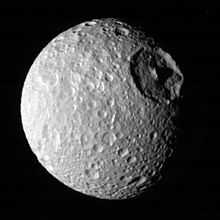Herschel (Mimantean crater)
Coordinates: 1°23′S 111°46′W / 1.38°S 111.76°W[1]

Herschel /ˈhɜrʃəl/ is a huge crater in the leading hemisphere of the Saturnian moon Mimas, on the equator at 100° longitude. It is named after the eighteenth century astronomer William Herschel, who discovered Mimas in 1789.
Herschel is the largest crater relative to its parent body of any equilibrium planetary moon in the Solar System.[2] It is so large that astronomers have expressed surprise that Mimas was not shattered by the impact that caused it. It measures 139 kilometres (86 miles)[1] across, almost one third the diameter of Mimas. Its walls are approximately 5 km (3.1 mi) high,[3] parts of its floor are 10–12 km (6.2–7.5 mi) deep, and its central peak rises 6–8 km (3.7–5.0 mi) above the crater floor.[4] If there were a crater of an equivalent scale on Earth it would be over 4,000 km (2,500 mi) in diameter and wider than Canada, with walls over 200 km (120 mi) high. The impact that formed Herschel must have nearly disrupted Mimas entirely. Chasmata that may be stress fractures due to shock waves from the impact traveling through it and focusing there can be seen on the opposite side of Mimas. The impact is also suspected of having something to do with the current 'Pac-Man'–shaped temperature pattern on Mimas.[3] Herschel has an estimated age of around 4.1 billion years[5] .
Media reception
The similarity between Mimas's appearance and the Death Star in Star Wars due to the large size of Herschel has often been noted, both in the press and in NASA/JPL press releases.[6][7] This is a coincidence, however, as the crater was not discovered until 1980, three years after the film was made.[8]
Gallery
-

Herschel at Mimas's terminator.
-

Image of Mimas taken by Cassini on its close flyby of February 13, 2010.
-

Cassini view of Herschel, showing crater wall albedo variation in lower left quadrant.
-

Closeup of part of Herschel, including its central peak.
-

Herschel crater in 3D.
References
| Wikimedia Commons has media related to Herschel (Mimantean crater). |
- ↑ 1.0 1.1 Blue, Jennifer. "Herschel". Gazetteer of Planetary Nomenclature. USGS Astrogeology Research Program.
- ↑ Craters on small moons such as Stickney may be comparably large ; the moons of dwarf planets have not been imaged.
- ↑ 3.0 3.1 "Goddard Instrument Aboard Cassini Spacecraft Sees 'Pac-Man' on Saturn Moon". Goddard Space Fight Center web site. NASA. 2010-03-29.
- ↑ Moore, Jeffrey M.; Schenk, Paul M.; Bruesch, Lindsey S.; Asphaug, Erik; McKinnon, William B. (October 2004). "Large impact features on middle-sized icy satellites" (PDF). Icarus 171 (2): 421–443. Bibcode:2004Icar..171..421M. doi:10.1016/j.icarus.2004.05.009.
- ↑ "Impact Crater Size-Frequency Distribution (SFD) and Surface Ages on Mimas." (PDF). 2011.
- ↑ Nicholas M. Short, Sr. "Remote Sensing Tutorial Page 19-18 "Saturn and its Moons"".
- ↑ "PIA12570: Flying by the "Death Star" Moon". NASA/JPL/Space Science Institute. 2010-03-29.
- ↑ Young, Kelly (2005-02-11). "Saturn's moon is Death Star's twin". New Scientist.
_(9505889).jpg)